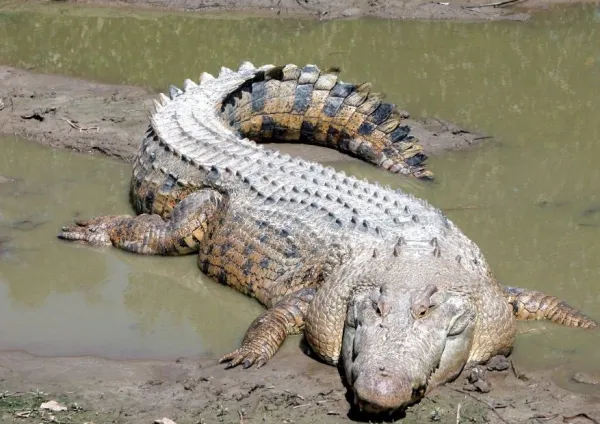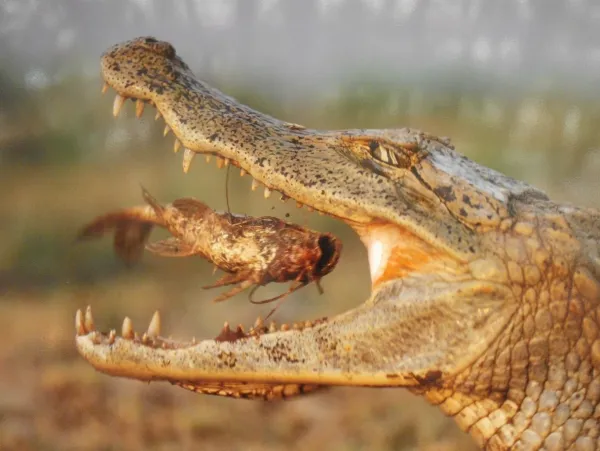Crocodiles (family Crocodylidae) are among the longest-surviving reptile lineages on Earth, with origins tracing back to the Eocene over 50 million years ago. In scientific usage, “crocodile” refers specifically to Crocodylidae; in everyday language, however, people often lump together other semi-aquatic predators such as caimans and alligators (Alligatoridae) and gharials (Gavialidae). This page focuses on true crocodiles (Crocodylidae): where they live, what they look like, how they reproduce, and what they eat.

Where Crocodiles Live: Habitats by Species
Key Features of Crocodiles
How Crocodiles Reproduce
What Crocodiles Eat
Core requirement: crocodiles are semi-aquatic and centered in tropical to subtropical regions. They occupy freshwater (rivers, lakes, marshes, floodplains) and brackish systems (river deltas, mangroves, lagoons), favoring slow currents, shallow margins, cover, and sunny banks for basking.
Dwarf Crocodile Osteolaemus tetraspis — Small-bodied; shaded forest swamps and creeks of Central–West Africa.
West African/Desert Crocodile Crocodylus suchus — Sahel–Nile oases, wadis, and river valleys.
Nile Crocodile Crocodylus niloticus — Africa’s most widespread crocodile; large rivers, lakes, and reservoirs.
African Slender-snouted Crocodile Mecistops cataphractus — Narrow snout; prefers dark, slow forested rivers and marshes.
Saltwater Crocodile (“Salties”) Crocodylus porosus — The largest living crocodile; estuaries, mangroves, deltas, coastal lagoons, and capable of open-sea travel.
Mugger/Marsh Crocodile C. palustris — Indian subcontinent ponds, lakes, irrigation tanks, scrub wetlands.
Siamese Crocodile C. siamensis — Southeast Asian lowland wetlands; now extremely rare in the wild and often seen in reintroduction sites.
Australian Freshwater Crocodile C. johnsoni — Northern Australia clear rivers, billabongs, and gorge pools.
Cuban Crocodile Crocodylus rhombifer — Endemic to Zapata Swamp and nearby freshwater marshes in Cuba.
Morelet’s (Mexican) Crocodile C. moreletii — Gulf lowlands rivers, wetlands, and limestone cenote lakes.
American Crocodile C. acutus — From Florida through Central to northern South America; favors estuaries, mangroves, and brackish coastal waters.
Orinoco Crocodile C. intermedius — Orinoco Basin (Venezuela–Colombia) main channels, seasonally flooded plains, and sandbanks.

Note: Salt tolerance varies by species. Saltwater crocodiles thrive in brackish and marine settings; many others still favor fresh–brackish mosaics.
Armor & build: Robust bodies clad in thick, keratinized scutes providing strong physical protection.
Longevity: Commonly 50–80 years in the wild.
Locomotion:
Aquatic: Propelled by powerful side-to-side tail strokes, limbs for trim and steering; largely nocturnal.
Terrestrial: Short, sturdy limbs; often belly-crawling. For bursts, they lift the body and can sprint up to ~18 km/h over short distances.
Thermoregulation: Ectothermic; frequently bask. Gaping (mouth held open) boosts evaporative cooling.
Ambush strategy: Long periods motionless at water’s edge; explosive strikes.
Sensory placement: Nostrils and eyes on the skull top, allowing breathing and lookout while the body stays submerged.
Jaw muscles: Exceptionally strong closing muscles for gripping prey; opening muscles are relatively weak—why even tape can restrain the jaws in handling scenarios.

Oviparous: Internal fertilization; females bury eggs in mound or pit nests of sand and vegetation. Heat comes from sun plus decomposing plant matter. Females typically guard nest sites.
Temperature-dependent sex determination (TSD): Nest temperature sets sex:
Around 33 °C → mostly males
Around 30 °C → mostly females
Parental care: Upon hatching, the female often gently carries hatchlings in her mouth to the water. High-pitched calls from young can summon protection.

Micro-habitat (shade, moisture, nest thickness) creates temperature gradients that influence sex ratios.
Adults: Apex ambush predators with very broad diets—fish, amphibians, reptiles, birds, mammals, and large invertebrates. Typical sequence: shoreline ambush → powerful bite → drag into water. They cannot chew; instead they tear and swallow, often using the famous “death roll” or cooperative tug-of-war.
Bite force is often described at the ~1,800 kgf level in popular summaries—illustrating their immense clamping power.
Juveniles: Start on insects, crabs, small fish, and small amphibians, scaling up with growth.
Local specialization: Diet tracks availability—mangroves mean more fish/crabs/waders; inland lakes mean more fish and terrestrial mammals coming to drink.
Bibliography
Rodríguez, M. A. (2000). Crocodiles (Archosauria: Crocodylia) of the Neotropical Region. Biota colombiana, Volume 1 (2), pp: 135-140.
Escibedo, A. H. (2000). Activity periods and the effect of environmental variables on crocodiles (Crocodylus acutus Cuvier 1807): Evaluating methods for determining the visible fraction. Applied Ecology, Volume 2 (1).
Christopher A. (2003). Phylogenetic approaches toward crocodylian history. Annual Review of Earth and Planetary Sciences, Volume 31, pp: 360.
animal tags: crocodile habitat
We created this article in conjunction with AI technology, then made sure it was fact-checked and edited by a Animals Top editor.